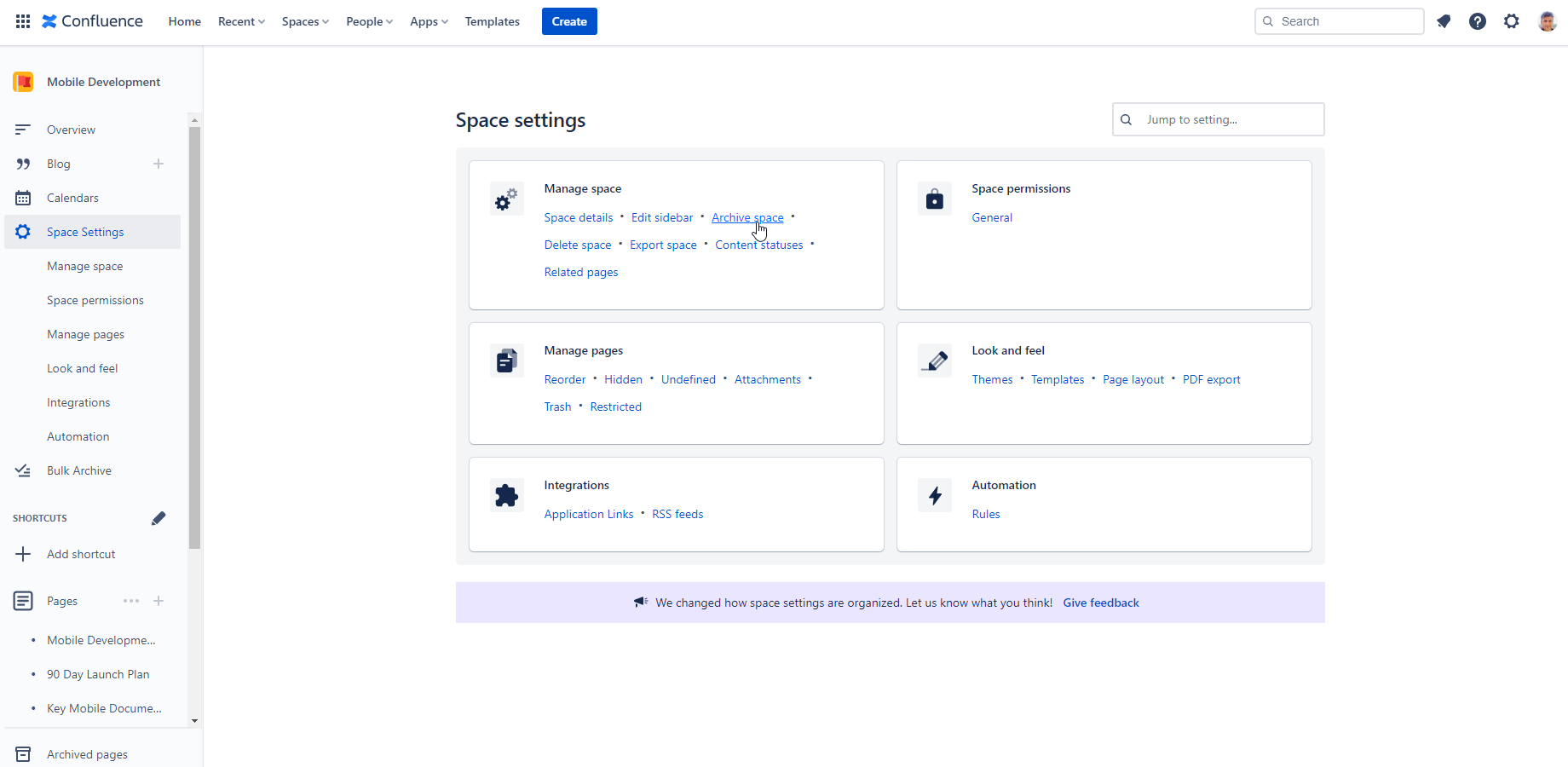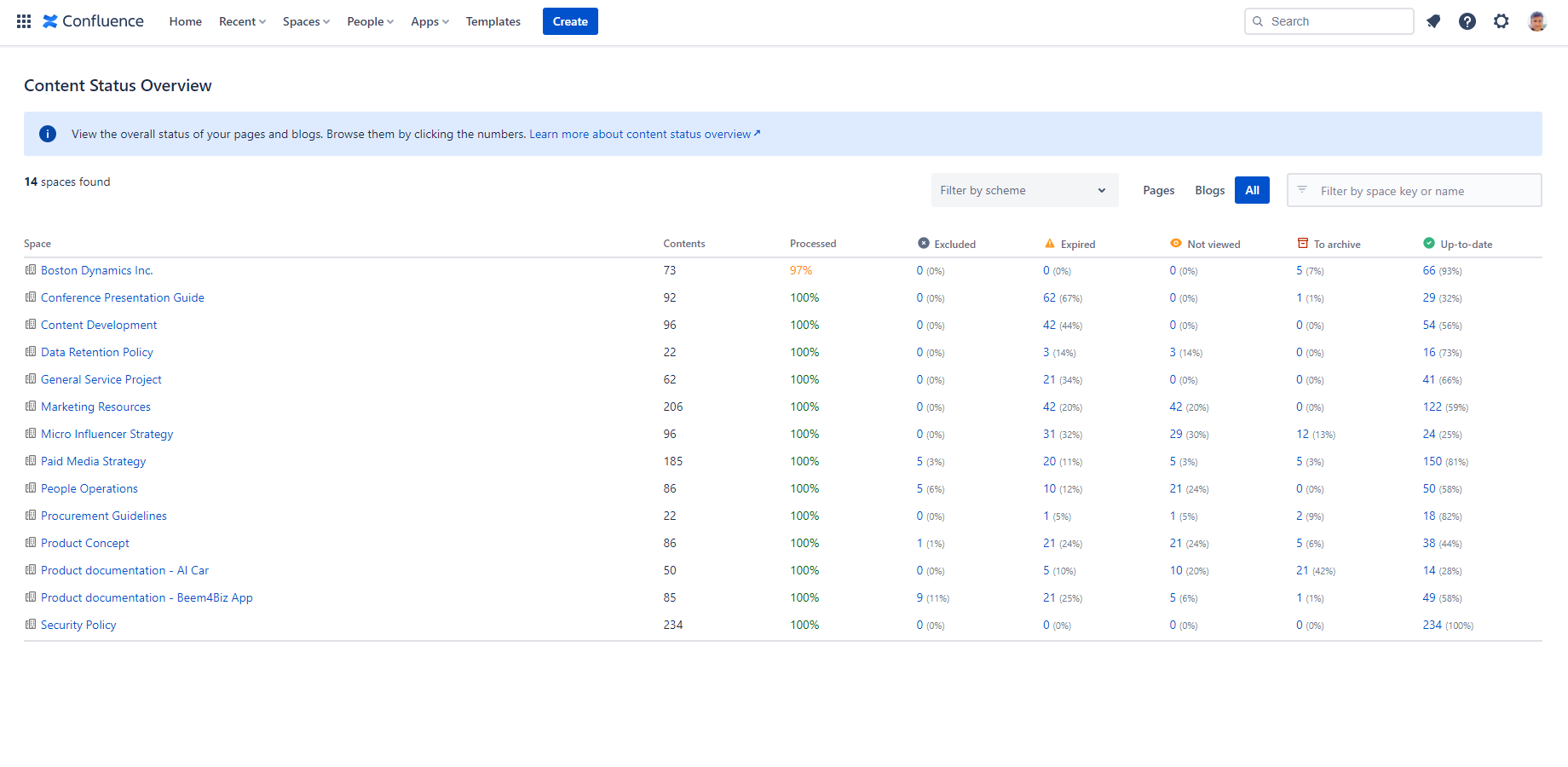Archiving a Confluence space means that the space will be hidden from search results and menu options. Its status changes to "Archive" from "Current". A Confluence archive space can be restored again.
How to archive a space in Confluence Cloud is often difficult to decide.
If you would like to hide Confluence content, archiving the complete space (including all its pages and blog posts) can work. If your goal is a long-term Confluence content lifecycle management strategy, you have other options.
A content lifecycle management system helps you with continuous page review workflow, expiration tracking, custom notifications to content owners and automated archiving. Read on to learn when and how to archive a space in Confluence and when to create a Confluence content lifecycle management strategy.
Why should you archive a Confluence space?
If you are confident that a Confluence space will not be needed anymore, you can archive the whole space in one go. In this case the goal is not to manage the content lifecycle, but to remove content from sight without deleting the content.
Another goal could be to hide certain parts of a page in Confluence. Hiding content can happen by adjusting page view permissions or by using Confluence visibility tools, like a Hide If macro.
Hiding content in a Confluence archive space have different motivations compared to managing the content lifecycle. You may want to hide a space due to team members having different knowledge privileges. Draft or content with different variations can also be hidden in Atlassian Confluence. Hiding Confluence content is not necessarily part of a lifecycle management strategy.
How to archive a space in Confluence Cloud?
Archiving is available for certain editions of Confluence, in different ways. Page archiving is not available for Confluence Cloud Free at all. You can archive pages in Confluence Data Center and starting from the Standard edition in Confluence Cloud. Bulk page archiving is supported in the Premium and Enterprise tiers.
Steps to archive a Confluence space:
- Go to Space settings.
- In the "Manage space" section select "Archive space".
- Click "Archive space".
You can set a space's status to "Archive" in Confluence space settings
The above steps are similar in both Confluence Data Center and Cloud sites. Archived content (an archive space) appears in your Space Directory. To maintain consistency, archived content can't be updated or edited, but can be viewed and restored.
When not to archive a Confluence space?
Check your motivations behind archiving or deleting a Confluence Cloud space. If you want to archive a space because it has too much outdated pages, but the space could still be used sometimes, don't archive or delete it entirely. Your team needs a Confluence content lifecycle management strategy instead, that keeps what's needed and archives the rest.
Teams (like the documentation team at the world's largest professional network) who implemented archiving and content lifecycle management strategies with Better Content Archiving for Confluence benefited from it. They saw improved Confluence user adoption, more relevant search results, and a more efficient work environment. For these teams, efficiency is not a "nice to have". It's a key performance driver in a challenging economic environment that saves money and peoples' nerves.
Strategy for a Confluence archive space
A Confluence content lifecycle management strategy is a framework that defines rules for when and how to archive a space in Confluence. It handles pages and groups of pages from creating content through maintaining to archiving.
A Confluence content lifecycle management strategy contains at a minimum:
- A clear understanding of the content types managed in Confluence (meeting notes, product documentation, corporate policy documents).
- Definition of expired content for each content type (in number of days).
- Definition of not viewed, abandoned content (in number of days).
- Designated content owners to notify (can be different people or groups for each content type).
- Notification email copy that explains what actions are expected from content owners.
- Definition for when content should be automatically archived.
- Ability to track actions in a log or audit trail.
An enterprise-grade Confluence content lifecycle management app makes sure that pages are continuously classified during their lifetime. A well-thought-out strategy with automated actions take much workload off of Atlassian Confluence admins and users.
Benefits
With a flexible and scalable Confluence Cloud content lifecycle management and archiving app you can:
- Apply different strategies to different types of content.
- Define custom Confluence page statuses and use them in automations.
- Launch a custom content review workflow for each team or department.
- Monitor content health reports and overview page statuses.
- Automatically notify content owners periodically, at a set date or at lifecycle events.
- Archive pages automatically when criteria are met.
- Search archived pages if needed and easily restore them.
- Review audit logs of automated and manual actions.
Confluence Content status overview report provided by Better Content Archiving
Read more on how to create a Confluence content lifecycle management strategy and see content review workflow examples.
Manage Confluence Cloud content lifecycle
Archiving a whole space is a not long-term solution for handling a growing Confluence Cloud instance. Archiving is not a one-time action, but a continuous effort to manage expired and not used pages in an archive version of a space.
Better Content Archiving for Confluence is an enterprise-ready product to help you view and implement your content lifecycle management strategy. It performs reliably with large instances and complies with Atlassian's security requirements as well.
Contact our expert team to ask for resources, have questions or if you want to know how to get started with a new strategy.
Design your content lifecycle management strategy to reap the benefits measured in dollars, team efficiency and improved Confluence user experience.


